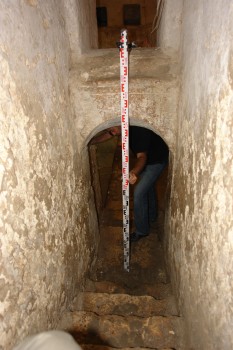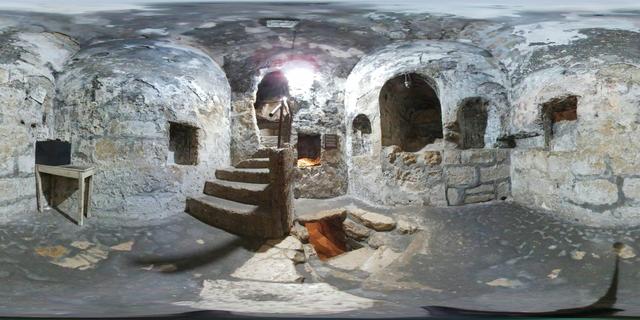 Source: http://palestineguesthouse.com/2011/02/20/sebastia-guesthouse/
The ancient ruins on the hilltop above Sebastia, a short drive from Nablus, are a popular destination for Israeli tour buses, but few of the groups on them ever stay long enough to venture into the small town below. In fact, the Israeli Tourism Ministry leaflets distributed for free at the archaeological site actively discourage them, pointing out that as ‘area A’ the village, unlike the ‘area C’ remains, is off-limits to Israeli citizens under Israeli law.
They’re missing a lot, because Sebastia is a beautiful little village, full of picturesque houses and stunning views. Some of the ancient buildings right in the centre of the village have been turned into an absolutely gorgeous little guesthouse, which combines the tumbledown stones of Byzantine-era walls with the clean, modern lines of some very nicely-done modern design. The rooms are simple, classy and contemporary, and very comfortable. Some real thought has gone into the running of the guesthouse – the soap in the bathrooms is made from local olive oil, breakfast is a locally-sourced spread of jam and fresh fruit from the orchards, village olive oil and za’atar, taboun bread and hummus (all served on a sunny terrace, if the weather suits). For guests wanting half- or full-board, hot meals can be fetched from local restaurants, or there is a shop in the village and a kitchen you can use. And the staff are delightful.
The guesthouse is an initiative of the Mosaic Centre (a community tourism organisation based in Jericho), the Franciscan Terra Sancta, and Sebastia Municipality. Other parts of the project include a tourist information centre on the village square (which can also teach mosaic-making classes and sells original and replica mosaics), and hikes around the village to sights such as the magams on nearby hills and the old Ottoman railway station.
***
Source: http://palestineguesthouse.com/2011/02/20/sebastia-guesthouse/
The ancient ruins on the hilltop above Sebastia, a short drive from Nablus, are a popular destination for Israeli tour buses, but few of the groups on them ever stay long enough to venture into the small town below. In fact, the Israeli Tourism Ministry leaflets distributed for free at the archaeological site actively discourage them, pointing out that as ‘area A’ the village, unlike the ‘area C’ remains, is off-limits to Israeli citizens under Israeli law.
They’re missing a lot, because Sebastia is a beautiful little village, full of picturesque houses and stunning views. Some of the ancient buildings right in the centre of the village have been turned into an absolutely gorgeous little guesthouse, which combines the tumbledown stones of Byzantine-era walls with the clean, modern lines of some very nicely-done modern design. The rooms are simple, classy and contemporary, and very comfortable. Some real thought has gone into the running of the guesthouse – the soap in the bathrooms is made from local olive oil, breakfast is a locally-sourced spread of jam and fresh fruit from the orchards, village olive oil and za’atar, taboun bread and hummus (all served on a sunny terrace, if the weather suits). For guests wanting half- or full-board, hot meals can be fetched from local restaurants, or there is a shop in the village and a kitchen you can use. And the staff are delightful.
The guesthouse is an initiative of the Mosaic Centre (a community tourism organisation based in Jericho), the Franciscan Terra Sancta, and Sebastia Municipality. Other parts of the project include a tourist information centre on the village square (which can also teach mosaic-making classes and sells original and replica mosaics), and hikes around the village to sights such as the magams on nearby hills and the old Ottoman railway station.
***
Sebastia in the news: how the ATS pro Terra Sancta project is slowly bringing tourists and pilgrims back to the town of John the Baptist
Pro Terra Sancta
\
News
\
Sebastia in the news: how the ATS pro Terra Sancta project is slowly bringing tourists and pilgrims back to the town of John the Baptist
 Source: http://palestineguesthouse.com/2011/02/20/sebastia-guesthouse/
The ancient ruins on the hilltop above Sebastia, a short drive from Nablus, are a popular destination for Israeli tour buses, but few of the groups on them ever stay long enough to venture into the small town below. In fact, the Israeli Tourism Ministry leaflets distributed for free at the archaeological site actively discourage them, pointing out that as ‘area A’ the village, unlike the ‘area C’ remains, is off-limits to Israeli citizens under Israeli law.
They’re missing a lot, because Sebastia is a beautiful little village, full of picturesque houses and stunning views. Some of the ancient buildings right in the centre of the village have been turned into an absolutely gorgeous little guesthouse, which combines the tumbledown stones of Byzantine-era walls with the clean, modern lines of some very nicely-done modern design. The rooms are simple, classy and contemporary, and very comfortable. Some real thought has gone into the running of the guesthouse – the soap in the bathrooms is made from local olive oil, breakfast is a locally-sourced spread of jam and fresh fruit from the orchards, village olive oil and za’atar, taboun bread and hummus (all served on a sunny terrace, if the weather suits). For guests wanting half- or full-board, hot meals can be fetched from local restaurants, or there is a shop in the village and a kitchen you can use. And the staff are delightful.
The guesthouse is an initiative of the Mosaic Centre (a community tourism organisation based in Jericho), the Franciscan Terra Sancta, and Sebastia Municipality. Other parts of the project include a tourist information centre on the village square (which can also teach mosaic-making classes and sells original and replica mosaics), and hikes around the village to sights such as the magams on nearby hills and the old Ottoman railway station.
***
Source: http://palestineguesthouse.com/2011/02/20/sebastia-guesthouse/
The ancient ruins on the hilltop above Sebastia, a short drive from Nablus, are a popular destination for Israeli tour buses, but few of the groups on them ever stay long enough to venture into the small town below. In fact, the Israeli Tourism Ministry leaflets distributed for free at the archaeological site actively discourage them, pointing out that as ‘area A’ the village, unlike the ‘area C’ remains, is off-limits to Israeli citizens under Israeli law.
They’re missing a lot, because Sebastia is a beautiful little village, full of picturesque houses and stunning views. Some of the ancient buildings right in the centre of the village have been turned into an absolutely gorgeous little guesthouse, which combines the tumbledown stones of Byzantine-era walls with the clean, modern lines of some very nicely-done modern design. The rooms are simple, classy and contemporary, and very comfortable. Some real thought has gone into the running of the guesthouse – the soap in the bathrooms is made from local olive oil, breakfast is a locally-sourced spread of jam and fresh fruit from the orchards, village olive oil and za’atar, taboun bread and hummus (all served on a sunny terrace, if the weather suits). For guests wanting half- or full-board, hot meals can be fetched from local restaurants, or there is a shop in the village and a kitchen you can use. And the staff are delightful.
The guesthouse is an initiative of the Mosaic Centre (a community tourism organisation based in Jericho), the Franciscan Terra Sancta, and Sebastia Municipality. Other parts of the project include a tourist information centre on the village square (which can also teach mosaic-making classes and sells original and replica mosaics), and hikes around the village to sights such as the magams on nearby hills and the old Ottoman railway station.
***

Donate Now
Support cultural, educational, and training activities
50.00$
80.00$
100.00$






Donate Now
Friend Sites
















